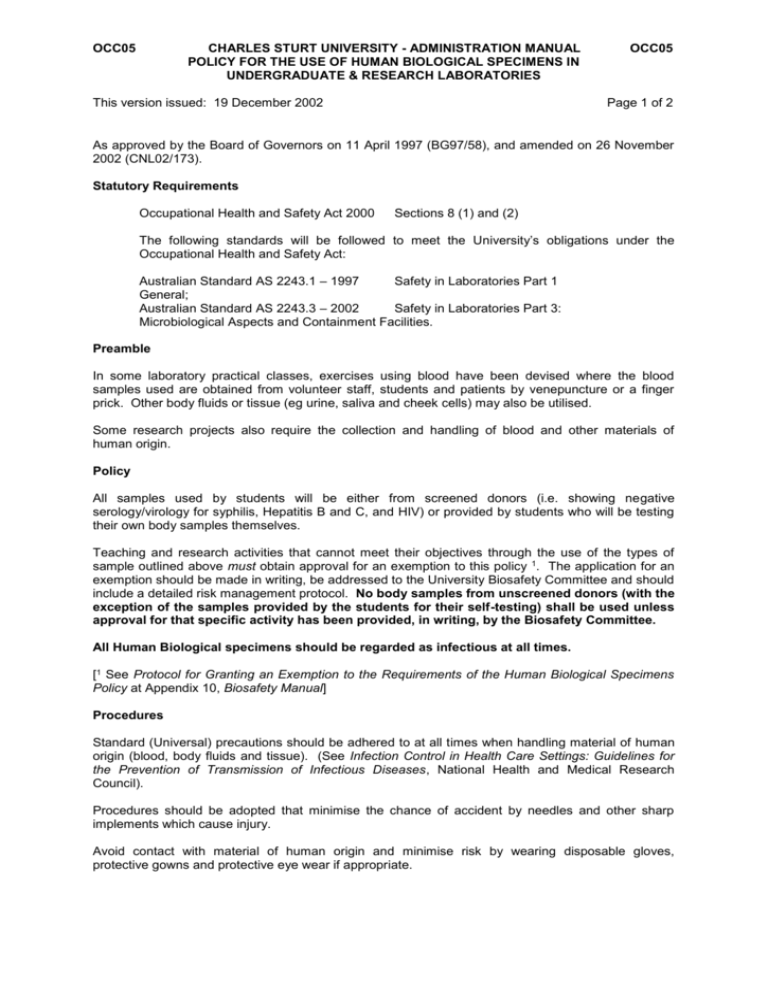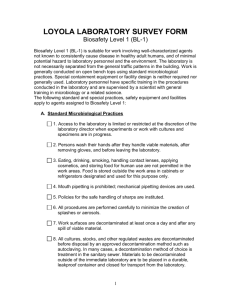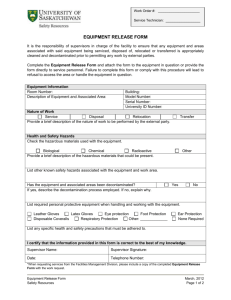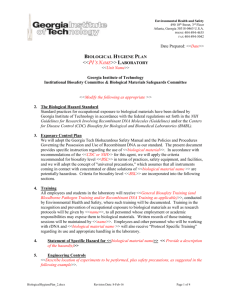policy for the use of biological specimens in undergraduate
advertisement

OCC05 CHARLES STURT UNIVERSITY - ADMINISTRATION MANUAL POLICY FOR THE USE OF HUMAN BIOLOGICAL SPECIMENS IN UNDERGRADUATE & RESEARCH LABORATORIES This version issued: 19 December 2002 OCC05 Page 1 of 2 As approved by the Board of Governors on 11 April 1997 (BG97/58), and amended on 26 November 2002 (CNL02/173). Statutory Requirements Occupational Health and Safety Act 2000 Sections 8 (1) and (2) The following standards will be followed to meet the University’s obligations under the Occupational Health and Safety Act: Australian Standard AS 2243.1 – 1997 Safety in Laboratories Part 1 General; Australian Standard AS 2243.3 – 2002 Safety in Laboratories Part 3: Microbiological Aspects and Containment Facilities. Preamble In some laboratory practical classes, exercises using blood have been devised where the blood samples used are obtained from volunteer staff, students and patients by venepuncture or a finger prick. Other body fluids or tissue (eg urine, saliva and cheek cells) may also be utilised. Some research projects also require the collection and handling of blood and other materials of human origin. Policy All samples used by students will be either from screened donors (i.e. showing negative serology/virology for syphilis, Hepatitis B and C, and HIV) or provided by students who will be testing their own body samples themselves. Teaching and research activities that cannot meet their objectives through the use of the types of sample outlined above must obtain approval for an exemption to this policy 1. The application for an exemption should be made in writing, be addressed to the University Biosafety Committee and should include a detailed risk management protocol. No body samples from unscreened donors (with the exception of the samples provided by the students for their self-testing) shall be used unless approval for that specific activity has been provided, in writing, by the Biosafety Committee. All Human Biological specimens should be regarded as infectious at all times. [1 See Protocol for Granting an Exemption to the Requirements of the Human Biological Specimens Policy at Appendix 10, Biosafety Manual] Procedures Standard (Universal) precautions should be adhered to at all times when handling material of human origin (blood, body fluids and tissue). (See Infection Control in Health Care Settings: Guidelines for the Prevention of Transmission of Infectious Diseases, National Health and Medical Research Council). Procedures should be adopted that minimise the chance of accident by needles and other sharp implements which cause injury. Avoid contact with material of human origin and minimise risk by wearing disposable gloves, protective gowns and protective eye wear if appropriate. OCC05 CHARLES STURT UNIVERSITY - ADMINISTRATION MANUAL POLICY FOR THE USE OF HUMAN BIOLOGICAL SPECIMENS IN UNDERGRADUATE & RESEARCH LABORATORIES This version issued: 19 December 2002 OCC05 Page 2 of 2 At the conclusion of all procedures, wash down bench tops and other surfaces with an appropriate disinfectant, for example, a strong solution of sodium hypochlorite (approximately 0.5% available chlorine), followed by 70% (w/w) alcohol (80% v/v), discard gloves into contaminated waste bag, place protective clothing in laundry bag and wash hands thoroughly with soap and water. In the event of an accident involving Human Biological Specimens, report it immediately to your supervisor or staff member in charge of the area or class where the accident occurs, and ensure that your supervisor follows up this action within 24 hours with the submission of a Biological Accident/Incident Report, using form BSC1, to the Biosafety Committee. Any accident involving injury or contamination to staff, students or visitors shall also be reported to the Human Resources Office using the Charles Sturt University Accident/Incident Report Form (NB: This form is a separate one to BSC 1). (See also Procedures for Dealing With Biological Accidents/Incidents in the University Biosafety Manual). Sharps Protocol 1. Needles and syringes are to be discarded only into approved containers. 2. Never attempt to replace the cap on a needle after use as this may lead to a 'finger-stick' injury. Injuries For injuries involving Human Biological Specimens, proceed to the Campus Medical Centre, or nearest hospital emergency department. This should be done without delay so the incident can be assessed and treatment offered within 24 hours if warranted. As indicated at Procedures above, ensure that you submit a Biological Accident/Incident Report (form BSC 1) to the Biosafety Committee within this same time period. Detailed guidelines are provided within the Procedures for Dealing With Biological Accidents/Incidents in the Biosafety Manual). Spills 1. If any body fluid is spilled, it should be cleaned up immediately with, for example, a strong solution of sodium hypochlorite (approximately 0.5% available chlorine), followed by 70% (w/w)alcohol (80% v/v). 2. Laboratory coats contaminated with body fluid must be decontaminated; for example, by placing in a chlorine bath for 30 minutes, prior to normal washing. 3. Material used to clean up the spill must be appropriately decontaminated prior to disposal; for example, by autoclaving or chemical sterilisation (NOTE: Do not autoclave materials soaked with hypochlorite solution due to the risk of toxic gas being produced).






